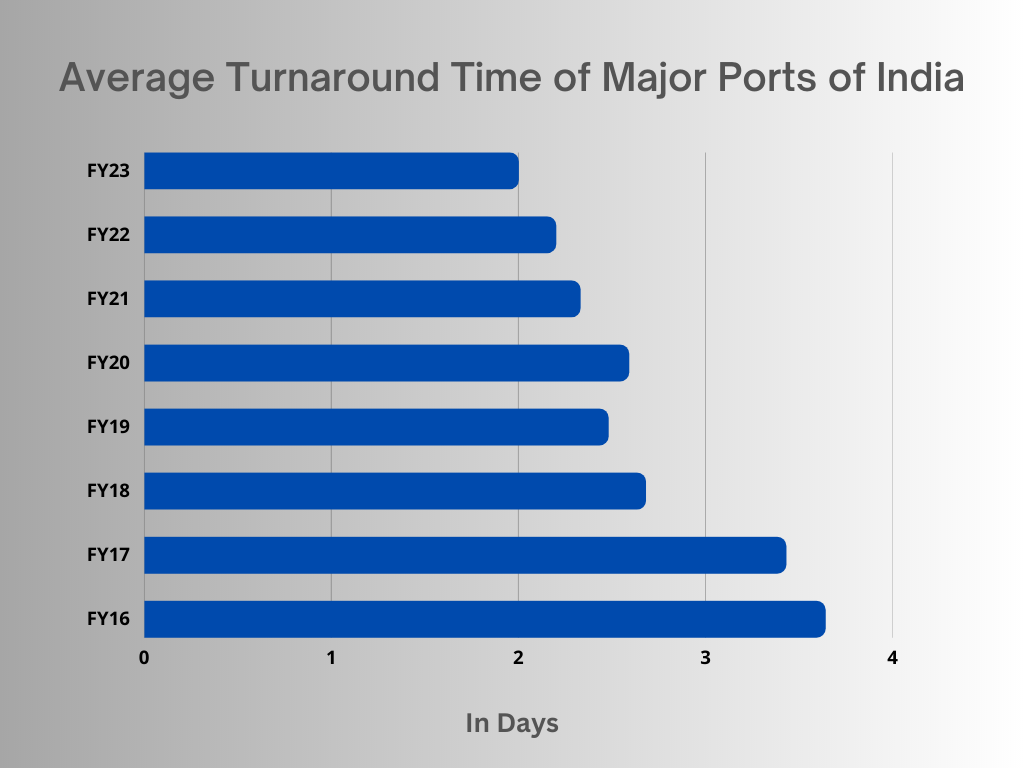The constant demand and supply in importing and exporting regions prevent sails from finding peace, placing a burden on ports and vessels. In this context, one common challenge they face is ensuring that ships can quickly unload and load their cargo and leave the port efficiently.The total span of time a vessel spends at a port is the vessel’s turnaround time (TAT). It is measured from the moment the ship enters the port till the moment it leaves.
TAT= Exit Time of vessel – Arrival time
To boost overall efficiency, all ports and terminals share the mutual goal of achieving fast and feasible TATs. In doing so, they can manage more vessel movements per day and increase their competitive edge when compared to other ports in the region. TAT is the key indicator of efficiency of ports, over the last eight years, average TAT at major ports of India has declined consistently from almost 3.64 days in FY 2016 to 2 days in FY 2023.
Along with this, India appears at 38th rank out of 139 countries in the 7th edition of Logistics Performance Index (LPI 2023) by World Bank. India has improved its logistics ranking in the World Bank Logistics Performance Index by climbing 6 places. On the strength of numerous efforts being undertaken over the past few years, India has experienced tremendous improvement on 4 out of 6 LPI metrics. Since 2015, the Indian government has made investments in trade-related soft and hard infrastructure that links port gateways on both coasts to the economic poles in the hinterland.

Initiatives like PM Gati Shakti, launched in 2021 and the National Logistic Policy in 2022 has contributed to transforming the logistic landscape and emphasized the shift towards more energy-efficient modes of transportation and greener fuels to reduce the carbon footprint, respectively. Technology has been a critical component of India’s logistics performance improvement efforts. Under a public-private partnership, a supply chain visibility platform has been implemented, which applies radio frequency identification tags to containers and offers consignees end-to-end tracking of their supply chain. This has helped to reduce delays. World Bank’s LPI Report 2023, has made global comparison of Indian Ports on the basis of ‘Turn Around Time’ parameter and has marked Indian Ports Turn Around Time as 0.9 days which is far better than some developed countries. Another cause behind this improved performance is the substantial fall in dwell time at Indian Ports, which has reached the optimum level of 3 days compared to 4 days in the UAE and 7 days in US. This indicates that, in comparison to the ports of other nations, Indian ports unloaded and loaded containers onto ships more swiftly.
However, Sagar Unnati Port data reveals that, the Turnaround Time for April-May 2023 of some major ports like Paradip Port, Chennai Port, New Mangalore Port, Mumbai Port, JNPT and Cochin Port are 1.71 days, 1.76 days, 1.67 days, 2.37 days, 1.14 days and 1.30 days respectively, but these statistics will constitute an average that will be higher than 2023 LPI report conclusions. The variation between LPI rankings and actual logistics data of countries may be due to the fact that LPI findings don’t take into account the entire population of logistic professionals and are based on sample of respondents, thus are subject to some sampling, response and measurement errors. Additionally, the rankings do not account for all aspects of logistics performance, including the effects on the environment and society, innovation and resilience, or service quality and reliability, which might not accurately reflect the state of the logistical environment at the time.

Although numerous Sagarmala projects are already in place to gain higher efficiencies in port operations and modernization of ports, the Turn Around Time can further be reduced by expanding and upgrading port infrastructure, including berths, container yards, and storage facilities. This allows for more efficient handling of vessels and cargo, reducing congestion and turnaround time. Implementing advanced automation technologies as it reduces manual handling, improves operational efficiency, and minimizes delays caused by human error. Encouraging the adoption of just-in-time principles by shipping lines and cargo owners can minimize storage time and optimize the timing of cargo arrivals, reducing the time vessels spend at port. Implementing performance monitoring systems to track key metrics, such as vessel turnaround time, container dwell time, and berth productivity and regularly analyzing data to identify bottlenecks and implementing corrective measures will surely ensure the desired TAT and meet the global standards.